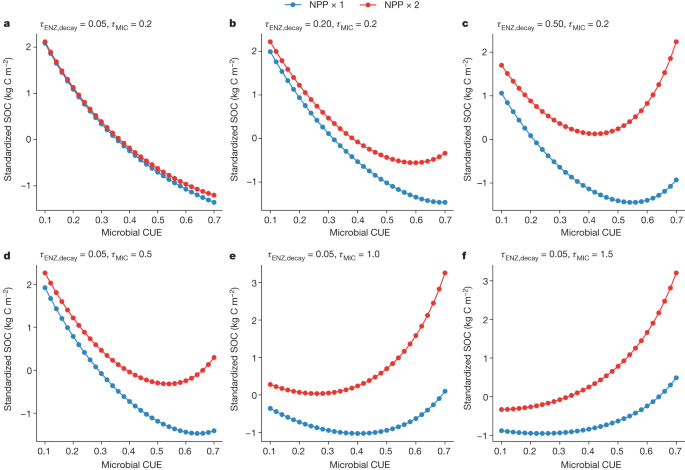Unveiling the Impact of Model Uncertainty on Soil Carbon Drivers
Core Concepts
The author argues that model uncertainty hinders the identification of a significant driver of soil carbon levels, emphasizing the importance of understanding microbial carbon use efficiency.
Abstract
The content delves into the impact of model uncertainty on identifying key drivers of soil carbon levels. It highlights the role of microbial carbon use efficiency in promoting global soil carbon storage and discusses how drought-induced reductions affect terrestrial net primary production. Additionally, it explores global gridded soil information based on machine learning and harmonized soil property values for broad-scale modeling. The article also touches upon spatially distributed datasets of soil coverage and carbon storage in permafrost regions, as well as the global soil organic carbon map. Furthermore, it addresses the spatial representation of organic carbon in high latitude soils and challenges the predictive capabilities of current net primary productivity models regarding future soil organic carbon sequestration potential.
Reply to: Model uncertainty obscures major driver of soil carbon - Nature
Stats
Tao, F. et al. Microbial carbon use efficiency promotes global soil carbon storage.
Zhao, M. & Running, S. W. Drought-induced reduction in global terrestrial net primary production from 2000 through 2009.
Hengl, T. et al. SoilGrids250m: global gridded soil information based on machine learning.
Batjes, N. Harmonized soil property values for broad-scale modelling (WISE30sec) with estimates of global soil carbon stocks.
Mishra, U., Drewniak, B., Jastrow, J. D. & Matamala, R. M. Spatial representation of organic carbon and active-layer thickness of high latitude soils in CMIP5 earth system models.
Minasny, B. et al. Current NPP cannot predict future soil organic carbon sequestration potential.
Quotes
Key Insights Distilled From
by Feng Tao,Ben... at www.nature.com 03-06-2024
https://www.nature.com/articles/s41586-023-07000-9
Deeper Inquiries
How does model uncertainty impact policy decisions related to soil conservation efforts?
Model uncertainty can significantly impact policy decisions related to soil conservation efforts by introducing doubt and ambiguity into the decision-making process. When models used to predict soil carbon dynamics are uncertain or lack accuracy, policymakers may struggle to determine the most effective strategies for managing and preserving soil carbon stocks. This uncertainty can lead to hesitancy in implementing certain policies, as the potential outcomes and effectiveness of these measures become less clear. Additionally, conflicting model results or interpretations due to uncertainties can create challenges in reaching consensus among stakeholders, further complicating the development of cohesive policies aimed at promoting soil conservation.
What are some potential drawbacks or limitations associated with relying on microbial carbon use efficiency to drive global soil carbon storage strategies?
While microbial carbon use efficiency plays a crucial role in promoting global soil carbon storage, there are several drawbacks and limitations associated with solely relying on this factor for driving strategies. One limitation is that microbial processes are influenced by various environmental factors such as temperature, moisture levels, and nutrient availability, which can fluctuate over time and space. This variability makes it challenging to accurately predict long-term impacts on soil carbon storage based solely on microbial activity.
Additionally, focusing exclusively on microbial carbon use efficiency may overlook other important drivers of soil carbon dynamics such as plant inputs, land management practices, and climate change effects. Ignoring these factors could result in incomplete or ineffective strategies for enhancing soil carbon sequestration capabilities globally. Therefore, while acknowledging the significance of microbial processes in influencing soil organic matter decomposition rates and stabilization mechanisms, it is essential to consider a holistic approach that incorporates multiple drivers of soil carbon dynamics for more robust and sustainable management practices.
How can advancements in machine learning techniques further enhance our understanding of complex environmental systems?
Advancements in machine learning techniques offer significant opportunities to enhance our understanding of complex environmental systems by enabling more accurate predictions, data analysis capabilities, and pattern recognition across large datasets. Machine learning algorithms have the capacity to identify intricate relationships between different variables within environmental systems that traditional statistical methods may overlook.
By leveraging machine learning models trained on diverse datasets encompassing various environmental parameters (such as climate data, land cover information), researchers can gain deeper insights into how different factors interact within ecosystems like soils. These advanced analytical tools allow scientists to develop predictive models that capture nonlinear relationships between variables affecting ecosystem functions like nutrient cycling or greenhouse gas emissions.
Furthermore,
machine learning algorithms facilitate real-time monitoring
of changes occurring within environmental systems,
providing valuable insights for adaptive management approaches.
Overall,
the integration of machine learning techniques
in studying complex environmental systems
can revolutionize our ability
to comprehend intricate ecological processes
and inform evidence-based decision-making towards sustainable resource management initiatives.
0
